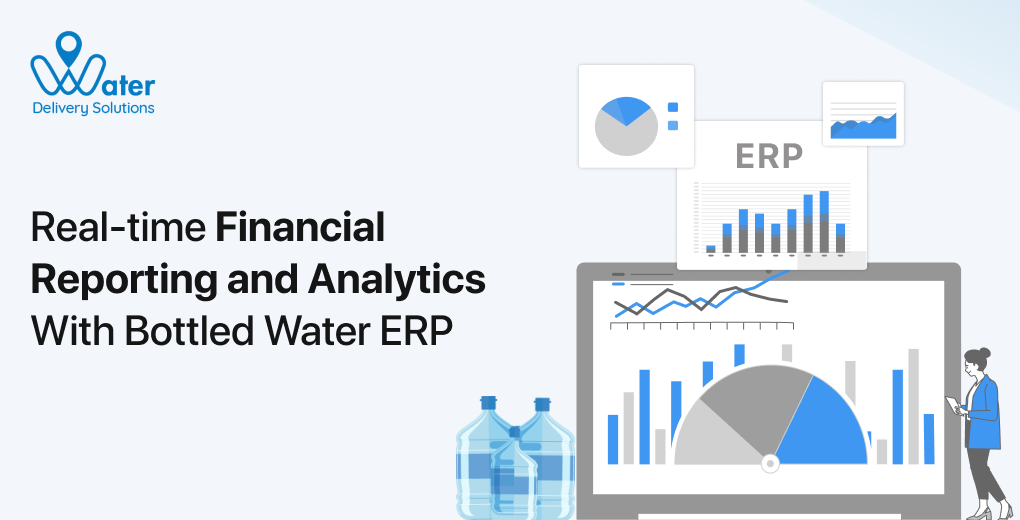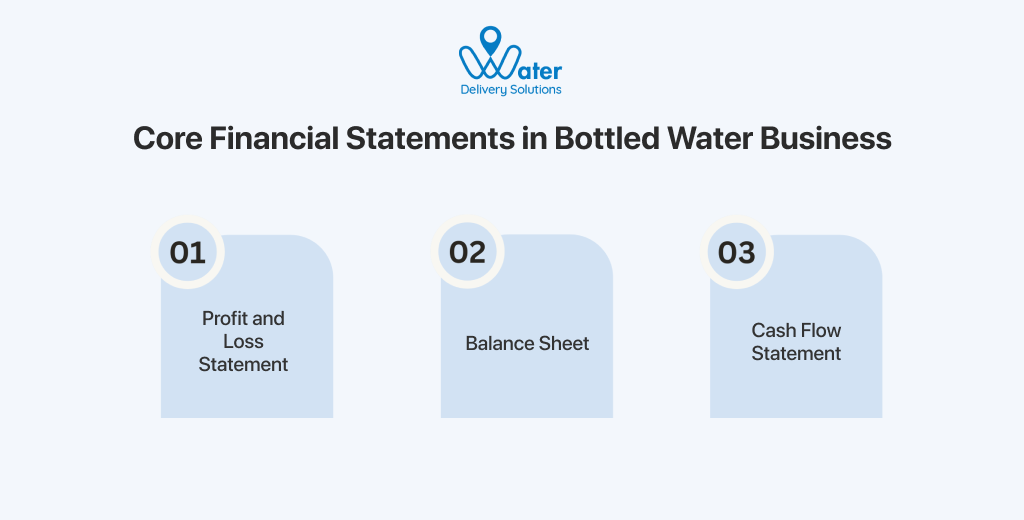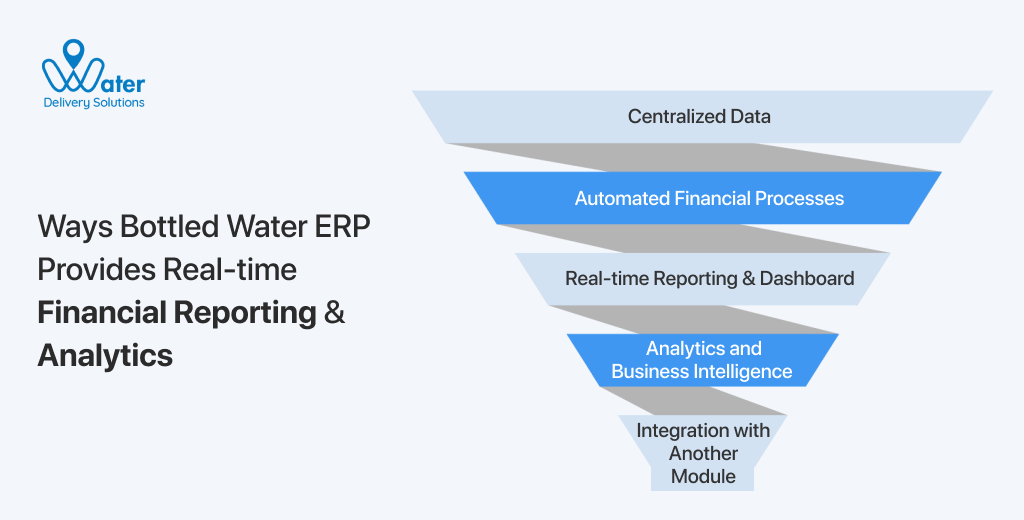Financial reporting and analytics are crucial aspects of any business; the bottled water businesses are no exception. Tracking and proactively managing business finances in real-time is essential for identifying and rectifying process issues to mitigate further losses. Water Delivery Solutions (WDS) offers a bottled water ERP that consolidates all financial data from various departments in real time and provides meaningful insights for informed decision-making.
The blog covers:
Understanding financial reporting and analytics in the bottled water business
Financial reporting and analytics in the bottled water business focus on providing a clear picture of a company’s financial performance and position. The core financial statements in bottled water businesses are:
Profit and Loss Statement / Income Statement
It is also known as the Income Statement or Financial Statement, which summarizes the revenues, costs, expenses, and profit or loss of a business during a specified period.
- Revenue – It is primarily driven by bottled water sales, bulk water sales, and potentially sales of flavor additives or other beverages. Revenue is tracked by product type, packaging type, capacity, and distribution channel.
- Cost of Goods Sold (COGS) – This includes direct costs associated with producing the bottled water. These costs include raw water cost, water purification and treatment costs, packaging material, production labor costs, and utilities.
- Gross profit – It is calculated by subtracting the Cost of Goods Sold (COGS) from the revenue. It indicates the profitability of the core production process.
- Operating expenses – These expenses are not related to production, but are necessary for running the business. They include marketing and advertising expenses, distribution costs, salaries for staff, rent (office, warehouse, and production facility), maintenance & repair for equipment, insurance, and depreciation of assets.
- Net profit – It is calculated by subtracting operating expenses and other non-operating items from the gross profit.
Balance Sheet
It is a financial statement that reports assets, liabilities, and shareholder equity at a specific point in time. This provides the basics for calculating rates of return for investors and evaluating a company’s capital structure.
- Assets – There are two types of assets: current and fixed assets. The current assets include cash, accounts receivable (money owed by customers), inventory (raw material, finished goods, empty bottles, caps, labels), and prepaid expenses. The fixed assets include land, buildings, machinery (filling lines and purification systems), delivery vehicles, and office equipment.
- Liability – There are two types of liabilities: current liabilities and long-term liabilities. The current liabilities include accounts payable (money owed to suppliers), short-term loans, and accrued expenses. Long-term liabilities include long-term loans and deferred revenue.
- Equity – The balance sheet provides a snapshot of the company’s financial health at a specific point in time.
Cash Flow Statement
It is a regular financial statement telling you how much cash you have on hand for a specific period. They are excellent for showing you how much money you have spent and earned; however, they do not show how much cash you have on hand for a specific time.
- Operating cash flow – Generated cash from core business operations and is vital for daily expenses, indicating the business’s ability to generate cash internally.
- Investing cash flow – Cash used for or generated from investments in long-term assets (purchasing new machinery or selling old equipment).
- Financing cash flow – Cash from debt or equity financing (taking out loans, issuing shares, repaying debts, or paying dividends). The cash flow shows how the cash moves in and out of the business.
Ways bottled water ERP provides real-time financial reporting and analytics
Water Delivery Solutions ERP for bottled water businesses is designed to provide real-time financial reporting and analytics through several core processes. The ways the bottled water ERP provides real-time financial reporting and analytics are:
Centralized data
The ERP system unifies data from all the departments (production, inventory, sales, distribution, finance, etc.) into a single database. This eliminates data silos and ensures the financial reports are consistent and up-to-date. As all business processes are integrated in the ERP, the data is updated and reflects the current state of operations.
Automated financial processes
ERP automates core accounting functions like general ledger management, accounts payable, accounts receivable, and cash management. This reduces manual error and speeds up the reconciliation process. The system can auto-generate invoices and enable you to track payments in real-time, providing a recent view of receivables and payables. You can integrate this ERP system with budgeting and forecasting tools, allowing you to create and compare scenarios based on real-time data for accurate financial planning.
Real-time reporting and customizable dashboard
You can generate various financial reports, including profit and loss statements, balance sheets, and cash flow statements, on demand to provide real-time insights into financial performance. The system includes customisable dashboards that allow users to monitor key performance indicators based on their roles. You can monitor sales revenue, production costs, inventory value, and profit margin. You can also generate detailed transaction-level data, allowing in-depth analysis and problem identification.
Advanced analytics and business intelligence
The bottled water ERP uses a built-in analytics tool to process the vast amount of financial data, enabling in-depth analysis of trends, patterns, and anomalies. To evaluate past financial data and forecast future trends in sales, costs, and demand, modern ERP includes predictive analytics and machine learning algorithms. This enables proactive decision-making, such as optimizing resource allocation and identifying cost-saving opportunities.
You can use these analytical capabilities to create and compare different financial scenarios, understanding the impact of various decisions. The ERP system also provides specific analytics for sales performance, inventory turnover rates, and stock movement patterns, which impact financial health.
Integration with another module
You can integrate multiple ERP modules, including production management, inventory management, supply chain management, and sales & distribution, with the reporting and analytics module.
- Production management – Real-time production data feeds directly into the financial module, providing accurate costs of goods and manufacturing overheads.
- Inventory management – Real-time inventory tracking, including stock leveling, valuations, and movement, impacting asset reporting and cost analysis. This helps manage inventory costs and avoid losses due to spoilage or overstocking.
- Supply chain management – It provides a financial picture of the supply chain, optimizing and reducing costs.
- Sales & distribution – Real-time sales data, order processing, and delivery information are immediately reflected in revenue recognition and accounts receivable, providing a clear view of sales performance and cash flow.
Benefits of real-time financial reporting and analytics
Water Delivery Solutions bottled water ERP enables proactive, data-driven decision-making throughout the entire company by providing sophisticated financial reporting and analytics for a real-time view of business finances. The benefits of real-time financial reporting and analytics are:
Faster decision-making
It provides immediate access to accurate financial data, facilitating quick, informed decisions regarding pricing, production levels, investment, and cost reductions.
Improved cash flow management
Real-time visibility into receivables and payables enables accurate cash flow forecasting, expense planning, and investment decisions.
Enhanced financial control
You can promptly identify irregularities, inefficiencies, and potential problems beforehand for better financial control and risk mitigation.
Increased agility
You can use real-time financial insights to improve your business’s ability to respond quickly to market changes and customer demand.
Optimized operations
You can identify areas of high expense or low profitability and make adjustments in real-time, improving efficiency and reducing costs.
Accurate forecasting and budgeting
Real-time data improved the accuracy of financial forecasts and budgets, ensuring more realistic planning.
Better regulatory compliance
Streamlined financial reporting and automated documentation help adhere to accounting standards and industry regulations.
Bottom line
Water Delivery Solutions (WDS) offers a cloud-based bottled water ERP that has transformed every aspect of the business with the introduction of automation, machine learning, and visibility. The bottled water businesses have not been left untouched. Being a highly regulated industry, implementing a bottled water ERP is a necessity. Adopting ERP can help you automate, optimize, and simplify business operations while improving efficiency and productivity and reducing cost overhead. If you are also looking to implement ERP in your business, schedule a call to discuss your requirements.

He loves to explore. His passion for helping delivery industries in all aspects flows through in the vision he has. In addition to providing smart solution to make delivery process flawless, Ravi also likes to write sometimes to make it easier for people from business industry looking for digital solutions.



